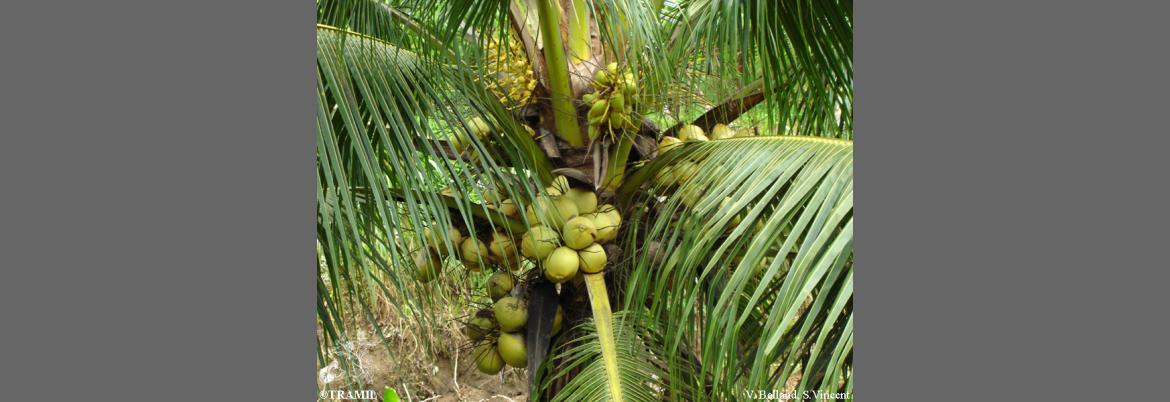1 BALLAND V, GLASGOW A, SPRINGER F, GAYMES G, 2004 TRAMIL survey. enda-caribbean, IICA, UAG & U.PARIS XI, Saint Vincent.
2 GERMOSEN-ROBINEAU L, GERONIMO M, AMPARO C, 1984 Encuesta TRAMIL. enda-caribe, Santo Domingo, Rep. Dominicana.
3 LAGOS-WITTE S, 1988-89, 1996 Encuesta TRAMIL. Laboratorio de Histología Vegetal y Etnobotánica, Departamento de Biología, Universidad Nacional Autónoma de Honduras UNAH, Tegucigalpa, Honduras.
4 CHARLES C, 1988 TRAMIL survey. Movement for Cultural Awareness MCA, Roseau, Dominica.
5 GIRON L, 1988 Encuesta TRAMIL (Costa atlántica). Centro Mesoamericano de Tecnología CEMAT, Guatemala, Guatemala.
6 WHO, 1991 Pautas para la evaluación de medicamentos herbarios WHO/TRM/91.4 (original inglés). Programa de Medicina Tradicional, OMS, Ginebra, Suiza.
7 MOURAFE J, BROWN WH, WHITING FM, STULL JW, 1975 Unsaponifiable matter of crude and processed coconut oil. J Sci Food Agr26:523.
8 PARIS R, MOYSE H, 1981 Précis de matière médicale.Paris, France: Ed. Maloine.
9 SAITTAGAROON S, KAWAKISHI S, NAMIKI M, 1985 Generation of mannitol from copra meal. J Food Sci50(3):757-760.
10 ATAKEUCHI K, 1961 Amino acids in the endosperm of some Amazonian Palmae. Chiba Daigaku Buurii Gakuba Kiyo Shizen Kagaku 3:321-325.
11 JANSZ ER, JEYA RAJ EE, PIERIS N, ABEYRATNE DJ, 1974 Cyanide liberation from linamarin. J Natl Sci Counc Sri Lanka 2:57-65.
12 KINDERLERER JL, KELLARD B, 1987 Alkylpyrazines produced by bacterial spoilage of heat-treated and gamma-irradiated coconut. Chem Ind (London) 16:567-568.
13 MANNAN A, AHMAD K, 1966 Studies on vitamin E in foods of East Pakistan. Pak J Biol Agr Sci9:13.
14 DUKE JA, ATCHLEY AA, 1986 Handbook of proximate analysis tables of higher plants.Boca Raton, USA: CRC Press. p47.
15 CAMBAR P, ALGER J, 1989 Efectos broncopulmonares del aceite de coco en conejos. Informe TRAMIL. Unidad de Farmacología, Facultad de Ciencias Medicas, Universidad Nacional Autónoma de Honduras UNAH, Tegucigalpa, Honduras.
16 CAMBAR P, 1987 Prevención de la producción de úlceras gástricas experimentales por algunos extractos de plantas.Informe TRAMIL. Unidad de Farmacología, Facultad de Ciencias Médicas, Universidad Nacional Autónoma de Honduras UNAH, Tegucigalpa, Honduras.
17 CACERES A, GIRON LM, ALVARADO SR, TORRES MF, 1987 Screening of antimicrobial activity of plants popularly used in Guatemala for the treatment of dermatomucosal diseases. J Ethnopharmacol 20(3):223-237.
18 VENKATARAMAN S, RAMANUJAN T, VENKATASUBBU V, 1980 Antifungal activity of the alcoholic extract of coconut shellCocos nucifera L. J Ethnopharmacol2(3):291-293.
19 JAIN SK, AGRAWAL SC, 1992 Sporostatic effect of some oils against fungi causing otomycosis. Indian J Med Sci 46(1):1-6.
20 CACERES A, MENENDEZ H, MENDEZ E, COHOBON E, SAMAYAO BE, JAUREGUI E, PERALTA E, CARRILLO G, 1992 Antigonorrhoeal activity of plants used in Guatemala for the treatment of sexually transmitted diseases. Facultad de Ciencias Químicas y Farmacia, Universidad de San Carlos, Guatemala, Guatemala. TRAMIL VI, Basse Terre, Guadeloupe, UAG/enda-caribe.
21 CACERES A, MENENDEZ H, MENDEZ E, COHOBON E, SAMAYAO BE, JAUREGUI E, PERALTA E, CARRILLO G, 1995 Antigonorrhoeal activity of plants used in Guatemala for the treatment of sexually transmitted diseases. J Ethnopharmacol48(2):85-88.
22 CACERES A, GIRON LM, MARTINEZ AM, 1987 Diuretic activity of plants used for the treatments of urinary ailments in Guatemala. J Ethnopharmacol19(3):233-245.
23 RODRÍGUEZ M, SÁNCHEZ C, 1982 Diuresis del agua de pipa (Cocos nucifera) en ratas. Rev Méd Panamá 7(3):186-19l.
24 KETUSINH O, 1954 Risks associate with intravenous infusion of coconut juice. J Med Ass Thailand 37(5):249-271.
25 MORTON J, 1981 Atlas of medicinal plants of Middle America.Springfield, USA: III: Charles C. Thomas Publisher.
26 BOOTH AN, BICKOFF EM, KOHLER GO, 1960 Estrogen-like activity in vegetable oils and mill by-products. Science 131:1807.
27 SALERNO JW, SMITH DE, 1991 The use of sesame oil and other vegetable oils in the inhibiting of human colon cancer growth in vitro. Anticancer Res 11(1):209-215.
28 LOCNISKAR M, BELURY MA, CUMBERLAND AG, PATRICK KE, FISCHER SM, 1991 The effect of dietary lipid on skin tumor promotion by benzoyl peroxide, comparison of fish, coconut and corn oil. Carcinogenesis 12(6):1023-1028.
29 BERTON TR, FISCHER SM, CONTI CJ, LOCNISKAR MF, 1996 Comparison of ultraviolet light-induced skin carcinogenesis and ornithine decarboxylase activity in sencar and hairless SKH-1 mice fed a constant level of dietary lipid varying in corn and coconut oil. Nutr Cancer 26(3):353-363.
30 CHINDAVANIG A, 1971 Effect of vegetable oils in plasma cholesterol in man and dog. Master Thesis, Dept. Biochemistry, Mahidol University, Bangkok, Thailand.
31 CARBALLO A, 1995 Cálculo de concentración y dosis de las drogas vegetales TRAMIL: Mensuraciones farmacognósticas y aproximaciones técnico-clínicas. Laboratorio Provincial de Producción de Medicamentos, Sancti Spiritus, Cuba.
32 Olmedo D, RODRIGUEZ N, ESPINOSA A, VASQUEZ Y, Gupta MP, 2005 Ensayo antimicrobiano de algunas especies con usos significativos TRAMIL-Centroamérica. Informe TRAMIL. Centro de Investigaciones Farmacognósticas de la Flora Panameña CIFLORPAN, Facultad de Farmacia, Universidad de Panamá, Panamá, Panamá.
33 GarcIa-GONZÁLEZ M, BARBOZA CJ, 2005 Velocidad del tránsito intestinal en ratones, del extracto acuoso del fruto fresco de Cocos nucifera. Informe TRAMIL. PRONAPLAMED. Depto de Fisiología, Escuela de Medicina, Universidad de Costa Rica, San Pedro, Costa Rica.
34 GarcIa-GONZÁLEZ M, BARBOZA CJ, 2005 Toxicidad aguda dosis repetida, en ratones, del extracto acuoso del aceite del fruto de Cocos nucifera. Informe TRAMIL.PRONAPLAMED. Depto de Fisiología, Escuela de Medicina, Universidad de Costa Rica, San Pedro, Costa Rica.
35 GarcIa-GONZÁLEZ M, BARBOZA CJ, 2005 Toxicidad aguda (5000 mg/kg) dosis repetida, en ratones, del extracto acuoso (decocción) del fruto fresco de Cocos nucifera. Informe TRAMIL.PRONAPLAMED. Depto de Fisiología, Escuela de Medicina, Universidad de Costa Rica, San Pedro, Costa Rica.
36 PAZOS L, COTO T, GONZALEZ S, 2006 Toxicidad oral subcrónica, dosis repetida, en ratón, de aceite del fruto fresco de Cocus nucifera. Informe TRAMIL. Laboratorio de Ensayos Biológicos, LEBi, Universidad de Costa Rica, San Pedro, Costa Rica.
37 PAZOS L, COTO T, GONZALEZ S, 2006 Irritabilidad dérmica, piel lesionada en conejos, del aceite del fruto puro de Cocus nucifera. Informe TRAMIL. Laboratorio de Ensayos Biológicos, LEBi, Universidad de Costa Rica, San Pedro, Costa Rica.
38 PAZOS L, COTO T, REYES L, 2007 Antiinflamatorio tópico, en ratones, del aceite del fruto de Cocus nucifera. Informe TRAMIL, Laboratorio de Ensayos Biológicos, LEBi, Universidad de Costa Rica, San Pedro, Costa Rica.
















